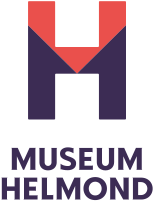
Maria van Brabant and the Oude Huys
A children’s playground in Helmond, inconspicuous houses, a concrete edge and a bronze statue by Rieky Wijsbek. She portrayed Maria van Brabant in 1988 as a noble lady with a falcon on her hand. On this spot, where there are now plenty of buildings, the Oude Huys (the Old House), the predecessor of Helmond Castle, once stood, where Maria held court.
In the banner an image by artist Christie van der Haak that she made for the exhibition about Mary of Brabant.
That image and the contour of the castle tower are all that is visible in the Helmond cityscape of Mary and her ‘Old House’. We know from research that she was a special and impressive woman who left her mark on history and culture. Although she led a rich and full life within the power politics of her time, Maria hardly appears in the books. What remains is a grave monument in Leuven (Belgium), a few drawings from centuries later, but no contemporary portrait.
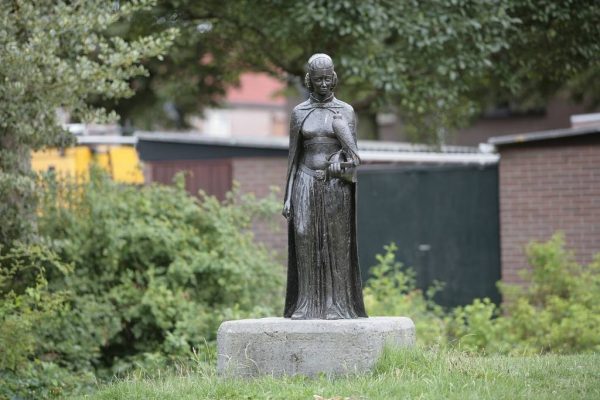
Bronze statue of Mary of Brabant by Rieky Wijsbek, 1988.
A strong woman
As the eldest daughter of Duke Henry I of Brabant, Maria is a noble lady with a high status. She was born in 1189 or 1190. Until the birth of her brother Henry II in 1207, she was her father’s only heiress. Maria will have been raised as a strong woman who knows what she wants. Her father regularly sends her on diplomatic missions. Mary is a desirable bride because of her high position. She marries twice, both marriages remain childless. Such as with Emperor Otto IV who was Emperor of the German Empire from 1214 to 1218.

Maria marries Otto IV in this depiction from centuries later, by Jan van Boendale (Royal Library of Brussels).
After his death, Maria married William I, Count of Holland between 1220 and 1222. Maria – as was the custom at that time – did not marry out of love, her marriages were political alliances to strengthen the position of the duke. In fact, her entire life revolves around a power game in which Maria is a plaything or a calculated strategist? We don’t actually know the answer to this question.
Nomad of stature
The noble Maria travels, as was normal at that time for people of her stature, as a kind of nomad between her homes and possessions. She lives, among other things, at her widow’s estate in Dordrecht and in the Affligem abbey. She regularly stayed at her castle, the Oude Huys, from 1235 onwards. After the death of her father in 1235, she committed herself to the development of Helmond.
Cultural and courtly life
With its wooden walls, the Oude Huys must have been an impressive and extensive swamp castle. Where it must have been lonely, bleak and draughty. Thick clothing, rugs and pillows provided comfort and warmth. The castle is far from rich Brussels, far from the world of emperors, kings, parties and noble entertainment. Yet Maria succeeds in turning the Oude Huys into an important center of cultural and courtly life, where poets and musicians reside. Art and religion give Mary extra prestige. This also included the foundation of her own monastery: the abbey for Cistercian sisters Locus Imperatricis or Keizerinnenplaats. This monastery in Binderen, north of Helmond, is a popular place for ‘pure virgins from a noble family’. After her death in 1260, the monastery inherited livestock, precious robes and jewelry, vernacular books, pottery and gold rings.
Wonderful legend
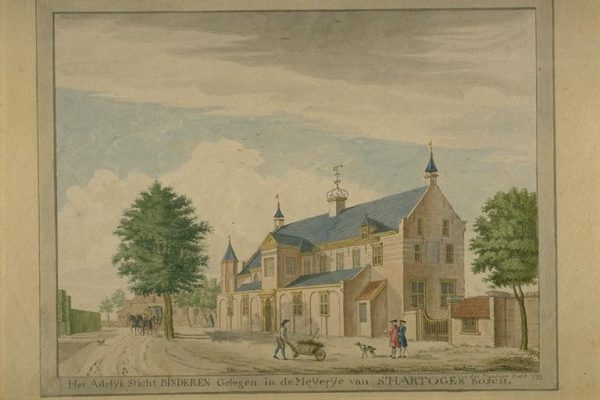
The Binderen monastery in earlier times
Miraculous legends often surround monastery foundations. Pastor A. Wichmans from Tilburg tells in his Brabantia Mariana of 1632 how the Empress Dowager strayed from her hunting procession and ended up with her mule in a swampy field near the Aa River. Maria slowly sinks into the swamp and shouts: ‘O God, I’m in!’ In this anxious moment, she vows to build a monastery in honor of the Virgin Mary for her salvation. This prayer is answered immediately. She gets a vision of 24 nuns in white habits, followed by 6 damsels, walking around a dunk or height. After this dream image, Maria chooses a sandy height near the Aa. On this island she founded the monastery under the name Binderen. The name already appears in a charter dated September 4, 1238 in which Mary’s brother, Henry II, announced the construction of the monastery. Now there is only a small chapel left that commemorates the monastery that was closed in 1651.
Archaeological research
Maria’s castle is located in the wet stream valley west of the settlement of Helmond. Several important roads intersect there. North-south there is the connection from Utrecht-‘s-Hertogenbosch to Maastricht-Liège-Aachen. From west to east there is the connection between Brussels-Leuven-Antwerp and Nijmegen-Gennep-Kleef. In 1256 there is talk of a ‘domo de Helmont’. After the construction of the current castle closer to the city, the Oude Huys gradually disappears, the materials are used for other buildings. In 1860, on the site of the Oude Huys, there was a dye house and later a yarn factory owned by J.A. Carp, who was married to Anna Wesselman, family of the later lord of the castle. During the construction of a factory chimney around 1917, a heavy layer of wooden beams emerged.
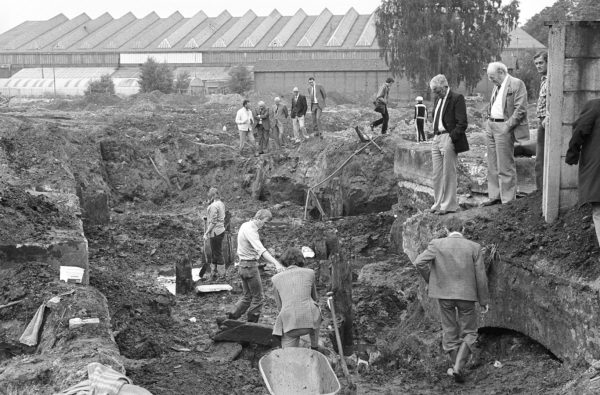
In 1981, amateurs from the then Heemkunde circle Helmond-Peelland excavated the remains of the Oude Huys. Photo press agency of de Meulenhof BV.
In 1980, a soil survey finally took place under the supervision of the Helmond-Peelland Heemkundekring, and between 1981 and 1982 they found numerous traces of an exceptional and extensive castle complex built on wooden piles. The amateur archaeologists found more than 200 wooden posts that point to, among other things, the traces of a round brick tower and no fewer than 9,228 larger and smaller objects. In any case, it concerns a castle built around 1188 in the Aa stream valley, which was the administrative center of the manor of Helmond from 1314 onwards.
What did the Oude Huys look like?
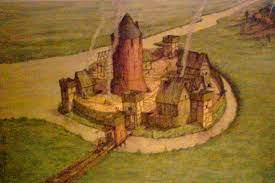
Example of what the old house may have looked like
People lived in the castle for about a century and a half, which has a wide moat with a bridge and a wooden gate tower. Within the canals is an earthen wall with a wooden defensive wall equipped with a kind of weather towers. There are wooden service buildings in the courtyard and a round brick tower is located at a height in the middle. So it is a so-called motte castle.
The round brick tower is the center of the castle, the size of the bricks and the Flemish brickwork indicate a construction date of around 1300. It would have been a residential tower or keep with probably stained glass windows, which indicates an important building. Maria’s keep probably had an above-ground storage cellar, a reception room with kitchen, private rooms, possibly an attic and a battlemented corridor for defense.
Unique in Europe
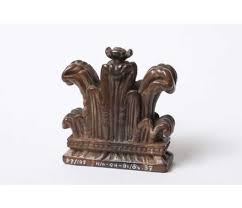
Ivory chess piece, one of the precious finds
The excavation of the remains of the Oude Huys is unique in Europe because of the size of the castle and the wealth of objects found, including bone and ivory chess pieces, bone tools, nails in all sizes, silver spoon handles and buckles.
Together with the large amount of pottery found in the canals, which served as rubbish dumps in the Middle Ages, they provide a good picture of life in and around the castle. Organic material is well preserved in the moist peat soil, such as food waste from hunting game and remains of pigs, cattle, horses, dogs and cats. Remains of hazelnuts and peaches, plums and walnuts have also been found. That shows that the residents were doing well.
The information about Maria van Brabant and the Oude Huys has been collected from the book Helmond Castle, Biography of a moated castle written by Wies van Leeuwen. The book is for sale in the castle shop, it is only available in Dutch.
